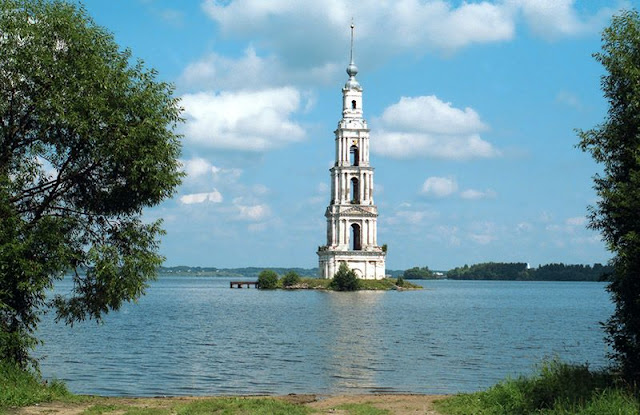The Kalyazin Bell Tower is a 244 feet Neoclassical campanile over the
waters of Volga River opposite the old town of Kalyazin, in Tver Oblast,
northwestern Russia. Kalyazin is a small town with a population of around
14,000 people. This town is 200km from Moscow and 160km from Tver. The steeple
belfry was built in 1796 as part of the Monastery of St. Nicholas. Of its 12
bells, the largest weighed some 17,000kg. Kalyazin Bell Tower is also known as
Nikolsky Cathedral Bell Tower, & Flooded Belfry.
It was cast in 1895 to commemorate the coronation of Nicholas II of
Russia. In 1939, Joseph Stalin ordered to construct Uglich Dam, then the old
parts of Kalyazin & architectural monuments were flooded and submerged
under the Ulich reservoir. This includes medieval structures, Saint Nicholas
Monastery and Troitsky Makariev Monastery.
In present days, katholikon was taken apart, while the campanile was
left, a landmark towering above the water. The Kalyazin Bell Tower structured
was severed as a marker for ships and sailors traveling the nearby towns.
However, occasionally this tower was also used by Orthodox Christian
ceremonies. You can still see majestic Bello tower is standing robustly risen
from the water and pursuit of modernization of Russia.
You will a little bit disappointed to see the empty inside of the tower
as fixtures and furniture were removed immediately before the water levels
rose. Whereas originally just a tower, it has been filled in a bit and
reinforced to give it more of an island stance. The average depth of 5 m and
deep as 23 m in some spots, as most of the buildings, were damaged and covered
by water.
Kalyazin Bell Tower is now becoming a popular tourist attraction, as
visitors come to see the iconic ancient tower and marvel the many centuries-old
structures. A small boat dock on the outside to facilitate the visitors. It
also entices the swimmers to have dipped in the water. If you are going to this
small beautify city, then make a plan to see this bell tower of the pre-Staling
history of the USSR. In Kalyazin you can also, see the Kremlin, Red Square, the
Mariinsky Theatre, and glimpses of everyday life in the USSR.
Product You May Interested
- Feel Emotional Freedom! Release Stress, Heal Your Heart, Master Your Mind
- 28 Day Keto Challenge
- Get Your Customs Keto Diet Plan
- A fascinating approach to wipe out anxiety disorders and cure in just weeks, to become Anxiety free, relaxed, and happy.
- Flavor Pairing Ritual Supercharges Women’s Metabolisms
- The best Keto Diet Program
- Boost Your Energy, Immune System, Sexual Function, Strength & Athletic Performance
- Find Luxury & Designer Goods, Handbags & Clothes at or Below Wholesale
- Unlock your Hip Flexors, Gives you More Strength, Better Health, and All-Day Energy.
- Cat Spraying No More – How to Stop Your Cat from Peeing Outside the Litter Box – Permanently.
- Anti-aging nutritional unexplained weight gain, stubborn belly fat, and metabolic slowdown. Reach Your Desired Weight in a Week and Stay There.
- Get All Your Healthy Superfoods In One Drink.


















































